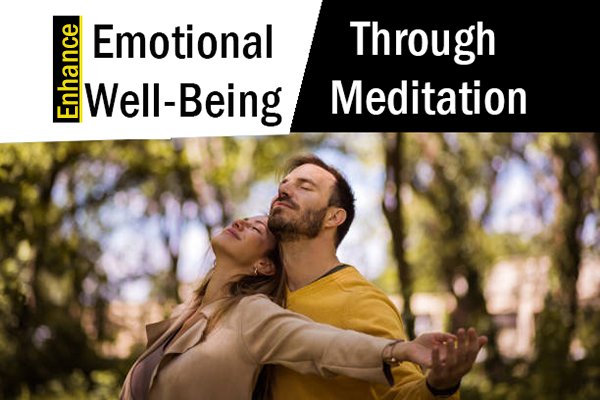Renew your life Today
In the midst of life’s chaotic crescendo, where emotions often surge and swirl like a tempest, the ancient practice of meditation emerges as a steadfast anchor. Beyond the tranquil exterior lies a profound journey into emotional well-being, unlocking the gates to a more balanced and resilient inner world. In this exploration, we navigate the intricate landscape of emotions, dissecting how meditation serves as a guiding light, offering solace, understanding, and a pathway to emotional harmony.
Navigating the Emotional Landscape
Emotions, the vibrant hues that color the canvas of our lives, can be both exhilarating and challenging. From the highs of joy to the depths of sorrow, the emotional landscape is vast and complex. In the pursuit of well-being, meditation stands as a time-honored practice, offering a sanctuary where one can explore the depths of their emotions with mindfulness and compassion.
Understanding Emotional Well-being
Before delving into the ways meditation influences emotional well-being, it’s essential to understand the concept itself. Emotional well-being extends beyond the absence of negative emotions; it encompasses the ability to understand, manage, and appreciate the full spectrum of feelings. It’s about forging a harmonious relationship with one’s emotions, allowing them to flow without overwhelming the individual.
Section 1: The Calming Breath – A Foundation for Emotional Resilience
Explore how the breath becomes a focal point in cultivating emotional resilience through meditation.
At the heart of emotional well-being lies the breath—a rhythmic dance that connects the mind and body. In meditation, the breath becomes a guide, a steady anchor amidst the turbulence of emotions. By consciously directing attention to each inhale and exhale, individuals create a space for emotional responses without being swept away by them. This mindful breath cultivates resilience, enabling one to navigate the ebb and flow of emotions with grace.
Section 2: Witnessing Without Judgment – Mindful Observation of Emotions
Introduce mindfulness as a tool for observing emotions without judgment, fostering a compassionate understanding.
In the sanctuary of meditation, individuals learn to observe their emotions with a compassionate gaze. Mindfulness teaches the art of being present with emotions without attaching judgments. As feelings arise, whether they be joy, sadness, anger, or fear, practitioners learn to witness them as passing clouds in the vast sky of consciousness. This non-judgmental observation reduces the grip of intense emotions, allowing them to be acknowledged and released.
Section 3: Cultivating Positive Emotions – Loving-Kindness Meditation
Highlight the practice of loving-kindness meditation as a means to foster positive emotions and compassion toward oneself and others.
Loving-kindness meditation, a powerful facet of meditative practice, directs positive intentions toward oneself and others. By actively cultivating feelings of love, compassion, and goodwill, individuals not only nourish positive emotions within but also extend this emotional warmth to the world around them. This practice serves as a counterbalance to negativity, promoting emotional equilibrium and a sense of interconnectedness.
Section 4: Emotional Resilience in the Face of Challenges
Explore how meditation contributes to emotional resilience, enabling individuals to face life’s challenges with greater strength.
Life is replete with challenges, and emotional resilience is the armor that empowers individuals to confront adversity. Through meditation, practitioners develop a grounded sense of self and a deep well of inner strength. When faced with difficult circumstances, this emotional resilience becomes a guiding force, allowing individuals to respond thoughtfully rather than react impulsively.Section 5: Healing Trauma – The Therapeutic Dimensions of Meditation
Discuss the therapeutic aspects of meditation in addressing emotional wounds and trauma.
For those carrying the weight of emotional scars, meditation offers a therapeutic journey toward healing. Mindfulness practices, when approached with the guidance of trained professionals, can provide a safe space for individuals to explore and release deeply rooted emotional trauma. The non-judgmental awareness cultivated in meditation becomes a gentle salve, facilitating the transformative process of emotional healing.
Section 6: Integrating Mindful Living – A Blueprint for Emotional Well-being
Emphasize the importance of integrating mindfulness into daily life as a blueprint for sustained emotional well-being.
Meditation is not confined to the cushion; its true impact is realized when it permeates daily life. Integrating mindfulness into routine activities—from eating to walking—sustains the emotional well-being cultivated during formal meditation sessions. By embracing mindful living, individuals carry the serenity and emotional intelligence cultivated in meditation into every aspect of their existence.
Conclusion: Embracing Emotional Harmon
In the tapestry of our emotional lives, meditation emerges as the thread that weaves harmony and resilience. The transformative power of this ancient practice lies in its ability to guide individuals through the kaleidoscope of emotions with mindfulness, compassion, and a deep understanding of the self. As you embark on this journey of emotional well-being through meditation, may you discover the profound beauty of embracing the full spectrum of your emotions, finding solace, and cultivating a resilient heart that beats in harmony with the rhythm of life.


